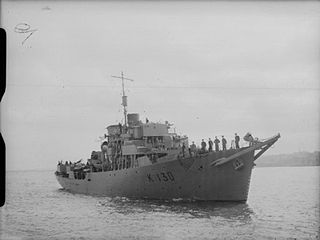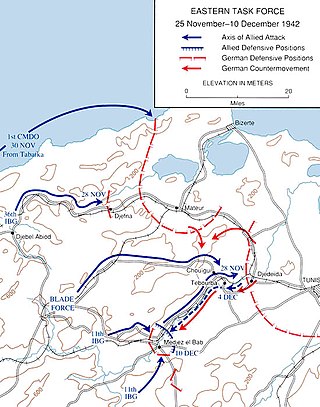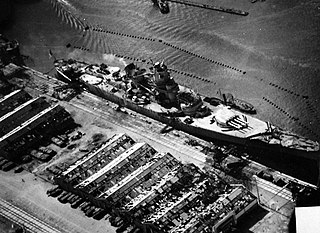
Operation Torch was an Allied invasion of French North Africa during the Second World War. Torch was a compromise operation that met the British objective of securing victory in North Africa while allowing American armed forces the opportunity to begin their fight against Nazi Germany and Fascist Italy on a limited scale. It was the first mass involvement of US troops in the European–North African Theatre and saw the first large-scale airborne assault carried out by the United States.
From 1939 to 1940, the French Third Republic was at war with Nazi Germany. In 1940, the German forces defeated the French in the Battle of France. The Germans occupied the north and west of French territory and a collaborationist régime under Philippe Pétain established itself in Vichy. General Charles de Gaulle established a government in exile in London and competed with Vichy France to position himself as the legitimate French government, for control of the French overseas empire and receiving help from French allies. He eventually managed to enlist the support of some French African colonies and later succeeded in bringing together the disparate maquis, colonial regiments, legionnaires, expatriate fighters, and Communist snipers under the Free French Forces in the Allied chain of command. In 1944, after the Allies had landed in Normandy and the southern front moved from North Africa across the Mediterranean into Italy and Provence, these forces routed the German Army, and Vichy officials fled into Germany.

Captain Henry Lockhart St John Fancourt was a British pioneering naval aviator, and held important aviation commands with the Fleet Air Arm during the Second World War. When Fancourt died at the age of 103, he was one of the last, if not the last, survivor who had actively been involved in the Battle of Jutland.

The attack on Mers-el-Kébir on 3 July 1940, during the Second World War, was a British naval attack on neutral French Navy ships at the naval base at Mers El Kébir, near Oran, on the coast of French Algeria. The attack was the main part of Operation Catapult, a British plan to neutralise or destroy neutral French ships to prevent them from falling into German hands after the Allied defeat in the Battle of France. The British bombardment of the base killed 1,297 French servicemen, sank a battleship and damaged five other ships, for a British loss of five aircraft shot down and two crewmen killed. The attack by air and sea was conducted by the Royal Navy, after France had signed armistices with Germany and Italy, coming into effect on 25 June.

The Battle of Madagascar was an Allied campaign to capture the Vichy French-controlled island Madagascar during World War II. The seizure of the island by the British was to deny Madagascar's ports to the Imperial Japanese Navy and to prevent the loss or impairment of the Allied shipping routes to India, Australia and Southeast Asia. It began with Operation Ironclad, the seizure of the port of Diego-Suarez near the northern tip of the island, on 5 May 1942.

The Battle of the Mediterranean was the name given to the naval campaign fought in the Mediterranean Sea during World War II, from 10 June 1940 to 2 May 1945.

The Malta convoys were Allied supply convoys of the Second World War. The convoys took place during the Siege of Malta in the Mediterranean Theatre. Malta was a base from which British sea and air forces could attack ships carrying supplies from Europe to Italian Libya. Britain fought the Western Desert Campaign against Axis armies in North Africa to keep the Suez Canal and to control Middle Eastern oil. The strategic value of Malta was so great the British risked many merchant vessels and warships to supply the island and the Axis made determined efforts to neutralise the island as an offensive base.
The Battle of Dakar, also known as Operation Menace, was an unsuccessful attempt in September 1940 by the Allies to capture the strategic port of Dakar in French West Africa. It was hoped that the success of the operation could overthrow the pro-German Vichy French administration in the colony, and be replaced by a pro-Allied Free French one under General Charles de Gaulle.
Operation Reservist was an Allied military operation during the Second World War. Part of Operation Torch, it was an attempted landing of troops directly into the harbour at Oran in Algeria.

HMS Malcolm was one of eight Admiralty-type destroyer leaders built for the Royal Navy during World War I. She was the first of only two Royal Navy ships to carry the name Malcolm, although HMS Valkyrie was originally planned to bear the name. She was one of two Admiralty-type leaders to miss the First World War but saw service in, and survived, the Second World War. Her pennant number was changed from D19 to I19 in May 1940. She was broken up in 1945.

HMS Broke was a Thornycroft type flotilla leader of the Royal Navy. She was the second of four ships of this class that were ordered from J I Thornycroft in April 1918, and was originally named Rooke after Rear Admiral Sir George Rooke of the Dutch Wars and the Battle of Vigo Bay.
Derek George Montague Gardner was an English painter. After a career as a civil engineer before and after serving in the Royal Navy in the Second World War, he became widely recognised as one of the leading English painters of marine subjects.

HMS Lotus was a Flower-class corvette that served in the Royal Navy.

USS Thomas Stone (APA-29) was a President Jackson-class attack transport that served with the United States Navy (USN) during World War II. She was damaged in combat and consequently did not see out the war. Thomas Stone received one battle star for World War II service.

The Run for Tunis was part of the Tunisia Campaign which took place during November and December 1942 during the Second World War. Once French opposition to the Allied Operation Torch landings had ceased in mid-November, the Allies made a rapid advance by a division-sized force east from Algeria, to capture Tunis and forestall an Axis build up in Tunisia and narrowly failed. Some Allied troops were fewer than 20 miles (32 km) short of Tunis by late November but the defenders counter-attacked and pushed them back nearly 20 miles (32 km), to positions which had stabilised by the end of the year.

The Naval Battle of Casablanca was a series of naval engagements fought between American ships covering the invasion of North Africa and Vichy French ships defending the neutrality of French Morocco in accordance with the Second Armistice at Compiègne during World War II.
Operation Kingpin was part of the run-up to Operation Torch, the planned Allied invasion of North Africa during World War II. It was a successor to Operation Flagpole, in which a secret meeting between U.S. General Mark W. Clark and diplomat Robert Murphy, representing the Allies, and General Charles E. Mast, the leader of a group of pro-Allied Vichy France officers in French North Africa, was arranged to secure their cooperation with the invasion. In Operation Kingpin, French General Henri Giraud, code-named "Kingpin", was released from confinement and brought to Gibraltar to meet with Operation Torch commander General Dwight D. Eisenhower and Clark in order to secure his cooperation with the invasion.
HMT Awatea was a trans-Tasman steam ocean liner built for the Union Steam Ship Company of New Zealand that was launched in 1936. From 1937 until 1939 she linked Wellington and Auckland in New Zealand with Sydney in Australia.
Force B was the name of several British Royal Navy task forces during the Second World War.
World War II was the first war where naval aviation took a major part in the hostilities. Aircraft carriers were used from the start of the war in Europe looking for German merchant raiders and escorting convoys. Offensive operations began with the Norwegian campaign where British carriers supported the fighting on land.











